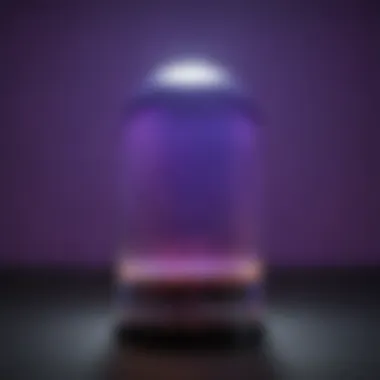Exploring Ultraviolet Light: Science and Applications


Intro
Ultraviolet light is a fascinating aspect of the electromagnetic spectrum, lying just beyond the visible range. Although humans cannot see it, its implications permeate various fields, from medicine to environmental science. Understanding ultraviolet light requires a grasp of its properties, detection methods, and the broader consequences of its presence and exposure.
Research Overview
Summary of Key Findings
Ultraviolet light is categorized into three types: UVA, UVB, and UVC. Each type possesses distinct characteristics and interacts with matter uniquely. Research indicates that UVA rays, which account for approximately 95% of the UV radiation reaching the Earth, penetrate the skin more deeply, contributing to photoaging and certain skin cancers. In contrast, UVB rays are primarily responsible for inducing sunburn and play a significant role in the production of vitamin D in the body. UVC rays, while the most harmful, do not reach the Earth's surface due to the protective layer of the ozone.
Importance of the Research in Its Respective Field
Understanding the nuances of ultraviolet light is critical in sectors such as healthcare, where it aids in sterilization processes, and in environmental studies, where it affects ecosystem dynamics. By grasping how UV light functions and its effects, researchers can better devise strategies to mitigate harmful exposure and enhance beneficial applications.
Methodology
Description of the Experimental or Analytical Methods Used
The analysis of ultraviolet light and its effects often involves spectroscopy and photometry techniques. Spectroscopy allows for the measurement of the intensity of UV light across different wavelengths, providing insight into the absorption and transmission properties of various materials. Photometric methods, meanwhile, assess how UV light interacts with biological matter, helping illustrate its potential risks and benefits.
Sampling Criteria and Data Collection Techniques
Data collection typically involves sampling different biological and environmental matrices. For example, in studies focusing on skin exposure, researchers often utilize human volunteers with varying skin types. Environmental studies may collect water and soil samples from locations with diverse UV exposure levels. Such thorough sampling ensures comprehensive insights into UV light's impact under real-world conditions.
Preface to Ultraviolet Light
Ultraviolet light plays a crucial role in both natural phenomena and various scientific applications. This section serves as an entry point to unpacking the complexities of this intriguing part of the electromagnetic spectrum. Understanding ultraviolet light is vital for anyone studying its effects, applications, or even the inherent risks associated with exposure. The significance of ultraviolet light spans across medicine, material science, and astronomy, further emphasizing the need for a comprehensive understanding of its properties and implications.
Definition and Characteristics of Ultraviolet Light
Ultraviolet (UV) light refers to electromagnetic radiation with wavelengths shorter than visible light, ranging approximately from 10 nanometers to 400 nanometers. Structurally, ultraviolet light is characterized by its high energy compared to visible light. This energy enables UV light to affect living organisms in beneficial and harmful ways. For example, it facilitates the production of vitamin D in the skin, yet excessive exposure can lead to skin damage and increase the risk of skin cancer. UV light is primarily categorized into three types: UVA, UVB, and UVC, each possessing different properties and effects on matter. Understanding these characteristics is vital for various applications, such as disinfection, phototherapy, and even artistic photography.
The Electromagnetic Spectrum and Ultraviolet Position
Ultraviolet light occupies a unique position within the broader electromagnetic spectrum, which includes radio waves, microwaves, infrared, visible light, ultraviolet, x-rays, and gamma rays. In this spectrum, UV light sits between visible light and X-rays, making it both essential and multifaceted.
The positioning of ultraviolet light implies specific interactions with materials and organisms. For instance, while visible light is crucial for human sight, UV light is not visible to the human eye. The interaction of UV light with biological tissues can trigger various chemical reactions, leading to both positive outcomes, like healing, and negative outcomes, such as cellular damage. Research into this spectrum aids in the development of technologies that harness these unique properties for beneficial purposes.
"Understanding the nuances of UV light can unlock new horizons in science, leading to advancements in health care, materials, and environmental studies."
By thoroughly examining the definitions and fundamental characteristics of ultraviolet light, alongside its position in the electromagnetic spectrum, readers can appreciate the importance of this topic. It sets the foundation for further exploration of the limitations of human vision and the myriad applications that follow.
The Limitations of Human Vision
Understanding the limitations of human vision is crucial in comprehending the broader context of ultraviolet light. Humans rely heavily on visible light for perception. However, this reliance comes with inherent restrictions. Our visual system is finely tuned to detect wavelengths from approximately 380 to 750 nanometers. This range encompasses all the colors visible to the naked eye, such as red, green, and blue.
However, the spectrum extends beyond what we can see. Ultraviolet light, which ranges from 10 to 400 nanometers, remains invisible to us. Not being able to perceive this spectrum affects both practical and theoretical aspects of science, technology, and health.
The inability to detect wavelengths outside our visible range not only limits our understanding of the environment but also impacts various fields where UV light plays a critical role. For example, in astronomy, missing out on ultraviolet data means losing valuable insights about stellar phenomena. This section will explore towards understanding these restrictions and their implications for both knowledge and application.
Understanding Visible Light Range
The visible light range encapsulates a small fraction of the electromagnetic spectrum. It begins at 380 nanometers and ends at 750 nanometers. Each wavelength corresponds to a different color. For instance, violet at the lower boundary transitions through blue, green, yellow, and red as it approaches the upper limit.
This specific range is further divided into segments that correspond to perception, such as:


- Violet: 380 - 450 nm
- Blue: 450 - 495 nm
- Green: 495 - 570 nm
- Yellow: 570 - 590 nm
- Orange: 590 - 620 nm
- Red: 620 - 750 nm
While humans depend on these visible wavelengths for navigation and communication, the assignment of meanings and emotion to colors greatly influences culture and human experience.
The Inability to See Ultraviolet Light
The setback of not perceiving ultraviolet light goes beyond simple curiosity. UV radiation, while non-visible, exerts significant influence in various sectors such as medical science and environmental studies. Skin health, for example, is directly linked to UV exposure. Prolonged exposure can result in skin damage, accelerated aging, and even conditions like skin cancer.
In the natural world, certain species have adapted to recognize ultraviolet patterns that are completely imperceptible to humans. For example, many plants and flowers display UV-reflective patterns that attract pollinators such as bees. Thus, not being able to see UV light limits our knowledge about life forms and ecological interactions.
"Understanding what lies beyond the visible spectrum is key in advancing both scientific inquiry and practical applications."
This limitation consequently affects our technological development. Innovative tools that leverage UV properties, such as UV sterilization devices, detect contamination that is invisible to human eyes, thereby highlighting the need for continued research in ultraviolet studies.
Through the exploration of visible light and its limitations, we gain insights into how these factors challenge and shape our understanding of the surrounding universe. By acknowledging the boundaries of human sight, we can formulate better technologies and methods to detect and analyze unseen wavelengths, leading to significant advancements in various fields.
Detection of Ultraviolet Light
Detection of ultraviolet light plays a crucial role in understanding its effects and applications across multiple domains. As UV radiation is invisible to the human eye, its detection often requires specialized instruments. Identifying UV light accurately is essential in fields such as medicine, material science, and astronomy. The ability to detect ultraviolet light not only enhances scientific research but also informs safety standards and public awareness regarding UV exposure.
Instruments designed for UV detection each have unique principles and applications. Some are ideal for capturing images under UV light, while others analyze or measure the intensity of UV rays. The choice of instrument directly impacts the quality of the data obtained. Let's explore three commonly used instruments for UV detection: UV cameras, spectrophotometers, and photodiodes.
Instruments for UV Detection
UV Cameras
UV cameras are highly specialized devices that capture images using ultraviolet light. They allow researchers to visualize phenomena that are otherwise invisible. One of the key characteristics of UV Cameras is their ability to produce detailed images under low-light conditions. This property is beneficial for various applications, such as forensic investigations and botanical studies.
A unique feature of UV cameras is their sensitivity to different UV wavelengths, enabling them to capture subtle variations in UV light. However, potential disadvantages include higher costs and the necessity for specific training to interpret data correctly.
Spectrophotometers
Spectrophotometers measure the intensity of UV light across different wavelengths. Their principal role is to determine the absorption qualities of materials when exposed to UV radiation. A significant advantage of spectrophotometers is their precision in quantifying UV light absorption, which is vital in chemical analysis and quality control.
The unique feature of spectrophotometers is their capability to provide detailed spectral data, revealing intricate interactions between UV light and materials. However, they typically require calibration and might not be as user-friendly as other instruments.
Photodiodes
Photodiodes are semiconductor devices that generate a current when exposed to light, making them effective for UV detection. Their simplicity and cost-effectiveness make photodiodes popular choices for various applications, including solar energy and environmental monitoring. One of their key characteristics is the ability to provide real-time measurements of UV light intensity, offering immediate feedback for research and safety monitoring.
A unique aspect of photodiodes is their versatility; they can be integrated into different systems for automated UV detection. However, they may have limitations in sensitivity compared to other UV detection instruments, which could affect data accuracy.
Working Principles of UV Detection Instruments
The mechanisms behind the instruments for UV detection vary according to their design and intended application. UV cameras operate on image sensor technology designed specifically for ultraviolet sensitivity.
Spectrophotometers utilize light sources that emit UV light, allowing for analysis of an object's light-absorbing properties by comparing transmitted and reference light.
Photodiodes function by converting light energy into electric current, relying on the photoconductive effect. This allows for efficient UV detection in various conditions.
Understanding these working principles aids in selecting the appropriate instrument based on the required sensitivity, ease of use, and specific applications.
Visualizing Ultraviolet Light
Understanding how to visualize ultraviolet light is essential in many scientific fields. It allows researchers to uncover information that is invisible to the naked eye but crucial in areas such as medicine, material science, and astronomy. By using specific techniques and tools, we can gain insights into the properties and behaviors of various substances when exposed to ultraviolet radiation. This section will explore two of the most effective methods: UV photography techniques and the use of specialized filters and lenses.
Using UV Photography Techniques


UV photography is a specialized method that captures images using ultraviolet light. Standard cameras cannot record UV light due to their filters and lens coatings. However, by modifying cameras and employing UV-sensitive film or digital sensors, it becomes possible to reveal details that are normally hidden.
In practical terms, using UV photography can enhance biological studies. For instance, the pigments of certain flowers and the markings of some animals become visible only under UV light. This capability provides valuable information for studies in botany and zoology.
Benefits of UV Photography Techniques:
- Reveals hidden patterns: UV photography shows structural patterns invisible in regular light.
- Enhances scientific research: It aids in the study of biological processes and interactions.
- Artistic possibilities: Artists leverage these techniques to create innovative images.
Despite its advantages, UV photography requires careful handling. The equipment must be protected from regular light during exposure to ensure that the results are accurate.
Specialized Filters and Lenses
Specialized filters and lenses are crucial in the visualization of ultraviolet light. These tools are designed to selectively transmit UV light while blocking visible wavelengths. When researchers and photographers employ such filters, they can isolate UV light and capture clearer images or measurements.
Using filters allows for greater control over the experiment or photo being taken. For example, in fluorescence microscopy, specific filters enhance the detection of fluorescent markers, thus providing more accurate data. These filters are vital in fields like cellular biology, where understanding the micro-level structures can lead to advancements in medical science.
Considerations in Using Filters and Lenses:
- Quality of the filters: The efficacy greatly depends on the quality. Higher-quality filters provide better results.
- Compatibility with equipment: Not all filters work well with every lens. It is crucial to ensure compatibility to avoid poor imaging.
- Care during use: Specialized lenses and filters are sensitive and require careful handling to avoid damage.
In summary, visualizing ultraviolet light aids in numerous fields through techniques like UV photography and the use of specialized equipment. It opens up pathways to understanding and exploring the unseen aspects of our world.
"The true beauty of science lies in its ability to reveal the hidden intricacies of nature."
This proactive exploration into UV light not only enhances existing knowledge but also inspires innovation across diverse disciplines.
Applications of Ultraviolet Light
The applications of ultraviolet light span across multiple fields, demonstrating its integral role in both scientific research and practical uses. Understanding these applications enriches the discourse surrounding UV light, highlighting how it can be employed beneficially. Each sector utilizes ultraviolet light to address specific challenges, contributing not only to advancements in technology but also to improved health outcomes and material quality. Emphasizing applications fosters appreciation for UV light's multifaceted essence.
Ultraviolet Light in Medicine
Ultraviolet light is increasingly recognized for its valuable applications in medicine and health. It is a vital component in several treatment modalities and preventive measures, which is crucial given the current emphasis on public health.
Treatments with UV Light
The treatment of skin conditions using UV light has gained attention. Phototherapy, often referred to in relation to psoriasis and eczema, is one such application. This method employs specific wavelengths of UV light to diminish inflammation and reduce abnormal cell proliferation. A key characteristic of treatments with UV light is the controlled use of energy to deliver therapeutic benefits, allowing for focused treatment of affected areas. This offers a beneficial choice for patients looking for alternatives to traditional medications. However, potential side effects include a risk of skin damage with excessive use, necessitating careful administration.
Disinfection and Sterilization
The use of ultraviolet light for disinfection purposes has proven effective, particularly in healthcare and water treatment facilities. UV radiation can deactivate bacteria and viruses by damaging their DNA. This mechanism makes disinfection a powerful application of UV light. A primary advantage of UV disinfection systems is their ability to sanitize without chemical agents, thus minimizing harmful residues. Nonetheless, there are limitations; for instance, UV light's effectiveness can be hindered by the presence of organic matter in water or air.
Material Science and Ultraviolet Light
In material science, ultraviolet light plays a significant role in product development and quality assurance, making it vital for manufacturing processes.
UV Curing Processes
UV curing is an innovative method used to harden inks, coatings, and adhesives through the application of UV light. This process accelerates drying times, enhancing production efficiency. A primary characteristic of UV curing includes its ability to provide immediate results without the need for solvents. This is why UV curing is a popular choice in industries like printing and automotive. However, while advantageous, it also necessitates stringent safety protocols due to the intense UV exposure.
Investigation of Material Properties
The investigation of material properties through UV light analysis offers insights into the integrity and characteristics of various substances. This approach is particularly relevant in quality control processes, highlighting the importance of UV spectroscopy in determining material composition. The key feature is its non-destructive nature, allowing for comprehensive assessments without damaging samples. However, its limitations include a requirement for baseline data to interpret results effectively.
Ultraviolet Light in Astronomy
In astronomy, ultraviolet light serves as a crucial tool for observing cosmic phenomena. Celestial bodies such as stars and galaxies emit UV radiation, allowing scientists to analyze their composition and behavior. Through instruments designed to capture UV emissions, researchers can gather data that would otherwise remain hidden from visible light observations. Such analysis provides insights into stellar formation and the properties of distant galaxies, enhancing our understanding of the universe. The advancement in telescope technology continues to expand our capability to investigate these UV signatures effectively.


The significance of ultraviolet light permeates various disciplines, underscoring its essential role in advancing both scientific knowledge and technological innovation.
Safety and Risks of UV Exposure
Understanding the safety and risks associated with ultraviolet (UV) exposure is critical. As we delve deeper into the applications of UV light, recognizing its potential hazards becomes paramount. UV radiation has indispensable roles across various sectors, yet its misuse poses significant health risks. Discussing the precautions and proactive measures can enhance the overall benefits of UV technologies while minimizing adverse effects.
Health Risks Associated with UV Exposure
Skin and Eye Damage
Skin and eye damage is one of the most prominent concerns related to UV exposure. The skin can suffer from severe burns when overexposed to UV radiation. Sunburn, known scientifically as erythema, arises from UV-B exposure, which leads to inflammation and pain. This aspect of skin damage is alarming; excessive inflammation can result in skin aging and even skin cancer. Understanding the dangers of UV can strengthen public awareness, guiding individuals to seek safe practices.
Moreover, the eyes are highly susceptible to UV light. Prolonged exposure can lead to conditions like cataracts or photokeratitis, which is akin to sunburn but on the cornea. These effects emphasize the delicate balance between utilizing UV for beneficial applications and ensuring safety. Protective eyewear is, thus, vital when working or being exposed to UV sources.
Long-term Effects
Long-term effects of UV exposure can be detrimental. Continued exposure might lead to chronic skin conditions and increased risk of skin cancers such as melanoma and keratinocyte cancers. These long-lasting impacts highlight the importance of UV protection. Moreover, the cumulative effect of UV radiation can degrade skin cell DNA, leading to mutations, which pose severe health risks.
The ongoing research into these long-term effects continues to solidify the understanding of UV risks. Continuous public education on UV exposure dangers can serve to decrease incidence rates of UV-related health issues. Integrating protective measures into daily routines is essential for lowering these risks.
Preventive Measures Against UV Exposure
Preventive measures can significantly reduce the health risks associated with UV exposure. Here are a few key strategies:
- Sunscreen Application: Using broad-spectrum sunscreen with an SPF of at least 30 can protect the skin from harmful UV rays. It's important to reapply it frequently, especially after swimming or sweating.
- Protective Clothing: Wearing long sleeves, hats with brims, and UV-blocking sunglasses offers physical barriers to UV radiation.
- Limiting Sun Exposure: Avoid outdoor activities during peak sun hours, which generally occur between 10 a.m. and 4 p.m.
- Regular Skin Checks: Monitoring skin for new or changing moles can lead to earlier detection of skin cancer.
- Education: Schools and community programs can promote awareness about the risks associated with UV exposure and emphasize best practices for protection.
Understanding these preventive measures supports both individual and public health, maximizing the use of ultraviolet light while safeguarding physical health.
Future Perspectives on Ultraviolet Light Research
Understanding the future of ultraviolet light research is essential for several reasons. As technology evolves, so does our capability to manipulate and utilize UV light across various fields. This not only enhances our understanding of fundamental science but also paves the way for innovative applications that can improve human life broadly. The ongoing advancements in UV technologies and their potential applications are at the forefront of research, often leading to unexpected discoveries.
Advancements in UV Technologies
Recent advancements in ultraviolet technologies have opened up new avenues for exploration and application. One significant area of progress is the development of more sensitive detection instruments. Instruments like advanced UV cameras and sensitive spectrometers are being engineered to provide detailed analyses of UV light interactions with different materials.
- Technological Integration: Integrating machine learning algorithms with UV detection systems enhances data analysis and interpretation. This technology helps in rapidly identifying UV signals that may be missed by traditional methods.
- Portable Devices: The creation of portable UV sensors is simplifying field studies. These devices allow researchers to collect data in remote locations, expanding the scope of environmental studies and biological monitoring.
- UV Light Sources: Innovations in UV LED technology are also noteworthy. These light sources are more energy-efficient and have longer lifespans compared to traditional mercury vapor lamps, reducing environmental impact.
Together, these advancements are reshaping our approach to studying and applying ultraviolet light. They simplify previous complexities and augment our capabilities, leading to a richer understanding of UV phenomena.
Potential Applications and Innovations
The potential applications of ultraviolet light are boundless, with ongoing research highlighting areas previously unimagined.
- Healthcare Innovations: In medicine, UV light is being explored for new treatments. For example, advancements in phototherapy for skin conditions and enhanced sterilization methods for medical instruments are vital focuses of research.
- Environmental Studies: Scientists are investigating the role of ultraviolet light in water purification processes. UV light effectively disinfects water, eliminating pathogens without the need for harmful chemicals.
- Material Science: UV curing processes are gaining traction in the manufacturing industry. New materials that cure faster using UV light are more efficient and environmentally friendly than traditional options.
The evolution of UV technologies is setting the stage for breakthrough discoveries that may redefine our understanding of both materials and biological systems.
- Astronomy Research: In the field of astronomy, advancements in UV telescopes are allowing researchers to study celestial bodies in greater detail. The data obtained from UV observations can reveal critical information about the universe's formation and composition.
In summary, future perspectives on ultraviolet light research are not just about scientific understanding. They are about harnessing knowledge for practical applications that have the potential to influence many aspects of modern life.
Epilogue
Understanding ultraviolet light is crucial for many fields including medicine, material science, and astronomy. This article sheds light on the various facets of UV light, enhancing our comprehension of its properties, detection, and applications. The implications of UV exposure and advancements in technology are also discussed, highlighting how this knowledge can influence safety practices, technological developments, and scientific research.
Summary of Key Points
- Definition and Characteristics: Ultraviolet light is part of the electromagnetic spectrum, situated beyond visible light, with wavelengths ranging from 10 nm to 400 nm.
- Limitations of Human Vision: Humans cannot see UV light, which illustrates the narrow scope of our perceptual capabilities.
- Detection Techniques: Various instruments such as UV cameras, spectrophotometers, and photodiodes are key for detecting UV light.
- Applications: UV light finds applications in medicine for treatments and disinfection, in material science for curing processes, and in astronomy for studying celestial objects.
- Safety Measures: Understanding the risks associated with UV exposure is vital to prevent adverse health effects.
- Future Research: There are exciting advancements in UV technology and potential applications that can further unlock the mysteries of UV light.
The Importance of Understanding Ultraviolet Light
Grasping the concept of ultraviolet light goes beyond academic interest; it impacts practical applications in daily life. For professionals in health and safety, knowledge about UV light can guide protective measures against its potential risks. In the context of scientific research, comprehending UV properties leads to innovations in numerous fields, from developing new medical treatments to enhancing materials through UV curing. As we advance into a future with increasing reliance on technology, the importance of UV light will only continue to grow, necessitating that students, researchers, and educators remain informed and engaged with this vital subject.







